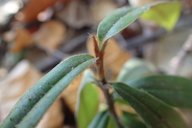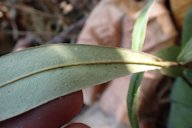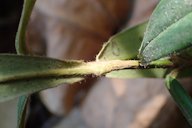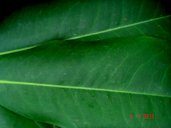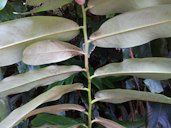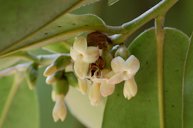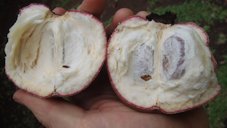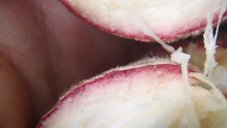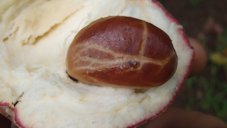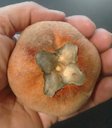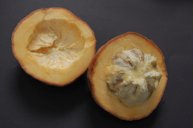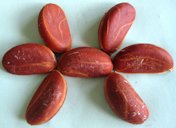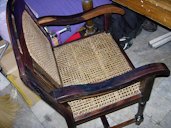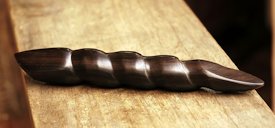| Mabolo - Diospyros blancoi | |||||||||||||||||||||||||||||||||||
|---|---|---|---|---|---|---|---|---|---|---|---|---|---|---|---|---|---|---|---|---|---|---|---|---|---|---|---|---|---|---|---|---|---|---|---|
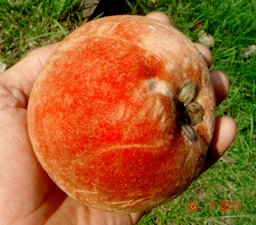 Fig. 1  Diospyros blancoi, mabolo, Subang Jaya, Selangor 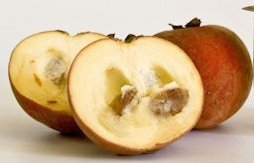 Fig. 2  Velvet apple (D. blancoi) 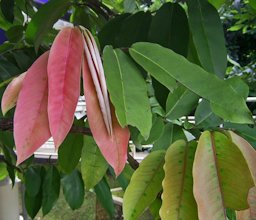 Fig. 3  D. blancoi, young pinkish leaves. Darmaga, Bogor, West Java, Indonesia 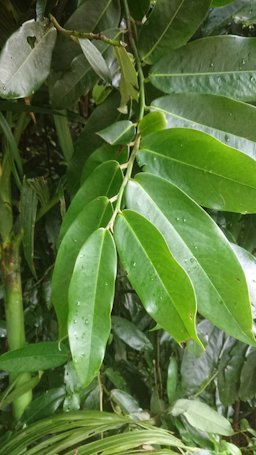 Fig. 4  Butter Fruit, D. blancoi, Taiwan 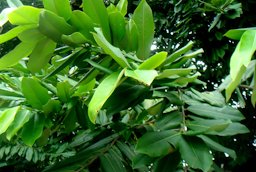 Fig. 5  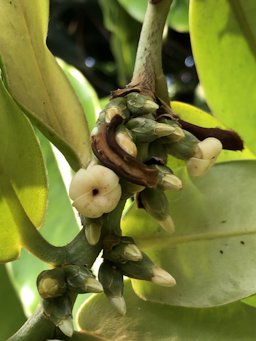 Fig. 12  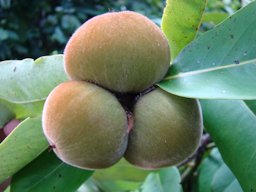 Fig. 14  Velvet apple aka mabolo display at the Redland Summer Fruit Festival, Fruit & Spice Park, Homestead, Florida. The scientific name had been changed from D. discolor to D. blancoi. 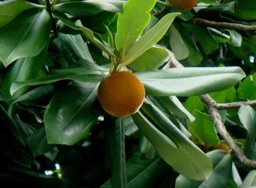 Fig. 15  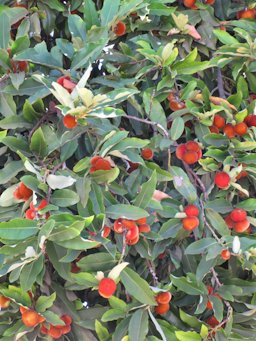 Fig. 23  D. blancoi (Mabolo), Fruit and leaves, Kahului, Maui, Hawai'i. 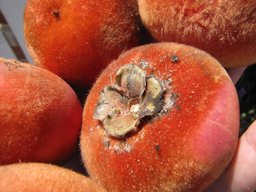 Fig. 24  D. blancoi (Mabolo), fruit, Kahului, Maui, Hawai'i 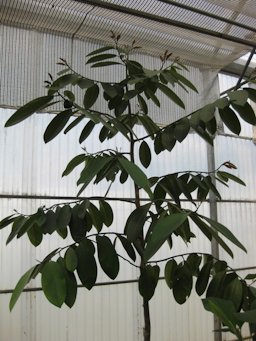 Fig. 25  D.blancoi, Queen Sirikit Botanic Garden (Chiang Mai Province, Thailand) 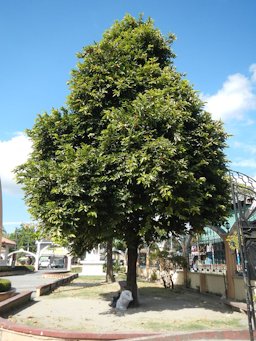 Fig. 26  D. blancoi in Baranggay San Nicolas Guagua, Pampanga 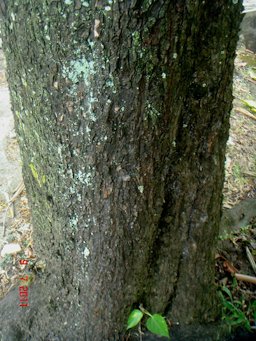 Fig. 27  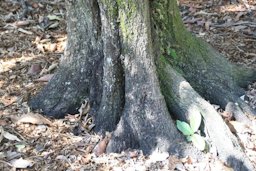 Fig. 28 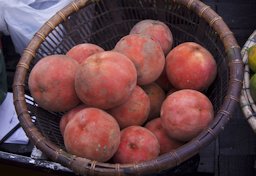 Fig. 29  Fruits for sale in Lok Baintan floating market. South Kalimantan, Indonesia. 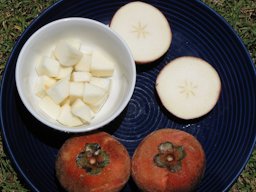 Fig. 30  Fruit cut in half and in bowl and whole, Olinda, Maui, Hawai'i |
Scientific
name Diospyros blancoi A. DC. Common names English: butter fruit, camogan ebony, mabolo, mabola persimmon, mabola-tree, velvet apple, velvet persimmon; Bangladesh: gab; Chinese: yi se shi; French: pommier velours; India: belanti gab, hong nhung (Hindu); Indonesia: bisbul, buah mentega; Japanese: ke gaki; Malaysia: buah mentega, buah lemah, buah sagalat, buah sakhlat, sagalat; Philippines: camagon, kamagong, mabolo, mabulo (tagalog); Portuguese: pécego-de-India; Spanish: camagón; Taiwan: mao shi, tai wan shi; Thailand: ma-rit; Vietnamese: hồng nhung 2 Synonyms D. mabola Lindl.; D. discolor Willd. nom. illeg.; D. kaki Blanco; Cavanillea philippensis Desr.; D. utilis Hemsley; D. philippensis Gürke 1,2 Relatives Black sapote (D. dignia), persimmon (D. kaki), American persimmon (D. virginiana), jackal berry (D. mespiliformis) an African species, date plum (D. lotus) from Asia 3 Family Ebenaceae (ebony family) Origin Philippines USDA hardiness zones Tropical, sub-tropical Uses Fruit; ornamental; wind break; shade tree; timber 2 Height 30-40 ft (9-12 m); larger in natural habitat Spread Narrow spread, sometimes of less than half the height 9 Crown Oval or conical-shaped crown Growth rate Slow growing Trunk/bark/branches Stout, dark-brown to black, furrowed trunk Pruning requirement Minimal; watersprout removal, dead or crossing branches Leaves Evergreen; alternate; oblong; entire; smooth, glossy upper surface; aromatic Flowers Dioecious; waxy white clustered male and solitary female flowers borne on separate trees 8 Fruit Berry; velvety, brown-reddish; persistent stiff calyx; skin thin; flesh whitish, firm, rather dry, sweet, astringent, aromatic 4 Season June to Sept. but occasional fruits may be found on the tree at almost any time of the year 5 Light requirement Full sun Soil tolerances Does best in loam but flourishes very well in almost any soil 5 Drought tolerance Drought tolerant when mature Aerosol salt tolerance Poor Soil salt tolerance Poor Cold tolerance Mature trees will freeze at 28 °F (-2 °C); younger trees injured at 30 °F (-1 °C) 9 Plant spacing Grafted young trees 26-33 ft (8-10 m) apart; seedling trees 33-50 ft (10-15 m) 4 Roots Shallow Invasive potential * None reported Pest/disease resistance No serious diseases or pests Known hazard The hairs may be somewhat irritating to sensitive skin 5 Reading Material Mabolo, Fruits of Warm Climates Diospyros blancoi, PROSEA Foundation The Mabolo, Manual Tropical Subtropical Fruits Mabolo - the Velvet Apple, Archives of the Rare Fruit Council of Australia Origin Mabola is indigenous to the low and medium altitude forests of the Philippine Islands from the island of Luzon to the southernmost of the Sulu Islands, and is also found in southern Taiwan (Guishan Dao, Hengchun peninsula, Lanyu) and Celebes in Indonesia. The tree was introduced into Java, Malaysia, India and subsequently elsewhere in the tropics. 2 It was first introduced into Florida in 1906, but is rarely seen outside of rare fruit collections. 3 Description In the Philippines, kamagong usually refers to the entire tree, and mabolo or tálang is applied to the fruit. It is a minor fruiting species that produces a fruit enjoyed by some, but avoided by others. The skin emits a rank, spoiled-cheese odor. This odor in not preseent it the flesh, which is of pleasant flavor. The tree itself makes a handsome and ornamental landscape specimen. Nevertheless, because of its limited appeal it is probably not well suited to the needs of the casual growers. 3 Leaves The evergreen, alternate leaves, oblong, pointed at the apex, rounded or pointed at the base, are 6 to 9 in (15-22.8 cm) long, 2 to 3 1/2 in (5-9 cm) wide; leathery, dark-green, smooth and glossy on the upper surface, silvery-hairy underneath. New leaves are showy, pale-green or pink and silky-hairy. 5
Fig. 6,7,8. Butter Fruit, D. blancoi, Pingtung, Taiwan Fig. 10,11. Butter Fruit, D. blancoi, Taiwan Flowers The tubular, 4-lobed, waxy, faintly fragrant blooms are short-stalked, creamy-white, downy. Male flowers ¼ in (6 mm) wide, in small clusters, and female flowers, ½ in (12.5 mm) wide, and solitary, are borne on separate trees. 5 Male trees must be interplanted for effective pollination. 7
Fig. 13. Flowers of D. philippinensis from Ebenaceae, Mumbai, India, the only place where this plant can be seen in the city Pollination Male trees must be planted near the female trees for effective pollination and fruit production. 5 Fruit Attractive and curious, the oval or oblate fruit, 2 to 4 in (5-10 cm) wide, has thin, pink, brownish, yellow, orange or purple-red skin, densely coated with short, golden-brown or coppery hairs, and is capped at the base with a dull-green, stiff calyx. The fruits are often borne in pairs, very close together on opposite sides of a branch. A strong, unpleasant, cheese-like odor is given off by the whole fruit but emanates from the skin, for it is absent in the peeled flesh, which is whitish, firm, mealy, somewhat like that of an overripe apple; moist but not very juicy; of mild, more or less sweet flavor, suggesting a banana-flavored apple. There may be 4 to 8 brown, smooth, wedge-shaped seeds, about 1 ½ in (4 cm) long and 1 in (2.5 cm) wide, standing in a circle around the central core, though the fruits are often completely seedless. Each seed is covered with a whitish membrane that is transparent when fresh, opaque when dried. 5
Fig. 16,17,18. Butter Fruit, Gianyar, Bali, Indonesia Fig. 19. Ripe mabolo fruit with persistent calyx, Acandí, Chocó, Colombia Fig. 20. Butter Fruit, D. blancoi, Sri Lanka Fig. 21. Buah Bisbul (Bahasa Indonesia), Buah Mentega (Bahasa Melayu), Mabolo (English), D. blancoi Fig. 22. Velvet apple fruit matured seeds; these seeds were obtained from a single fruit, Kolkata, West Bengal, India Varieties Few cloned varieties are available in Florida. the cultivars 'Manilla' and 'Valesca' bear quality fruit that is usually seedless. 3 Harvesting It takes 4 months for the fruit to mature from anthesis. 6 In Florida, the mabolo ripens in the summer and early fall. Maturity is indicated when the fruit reaches full size and coloration. The fruit is usually clipped from the tree. 3 Generally, the season for fruit is only a few months; during that time, large amounts of fruit might be produced. 9 Propagation Usually propagated by seeds (24 days to germinate), it can also be propagated by air layering, budding, grafting (especially shield and cleft grafting) and rooted shoot cuttings. 6 Seedling trees tend to grow upright, sometimes with just a single, unbranched trunk. Grafted trees, however, grow short in stature and produce more lateral branches. Seedling trees bear fruits 6-7 years after planting; grafted trees in 3-4 years. Trees vary mainly in the shape and hairiness of the leaves and shape and taste of the fruits. 4 Pruning Watersprouts and interlacing branches are occasionally pruned; so are branches that touch the ground. 4 Culture Due to their slow growth rate, trees benefit from light, frequent fertilizing with a good quality fruit tree fertilizer. Mature trees, especially on alkaline soils, develop severe chlorotic conditions and deficiencies of iron and manganese. Since the root systems seem to be very shallow, mulching is also considered to be extremely beneficial; this helps to conserve soil moisture and cut down on competition from weeds. 9 Irrigation It is drought tolerant, requiring irrigation only during the establishement phase. 3 Pests/Diseases A number of bees, leaf rollers, caterpillars and red scales have been reported on shoots and leaves. No major pest or disease has been identified. 6 Food Uses The surface fuzz adheres tightly even when the fruit is ripe. Also, the skin, though thin and pliable, is tough and papery when chewed. Therefore, the fruits should be peeled before eating, and then kept in the refrigerator for a few hours before serving. Then the odor, which is mainly in the skin, will have largely dissipated. 5 The ripe fruit is peeled and eaten fresh, or used in salad or stewed or fried like a vegetable. The flesh is also diced and combined with that of other fruits in salads. The flesh can be seasoned with lime or lemon juice or Grenadine syrup and serve fresh as dessert. If stewed in sirup, the flesh becomes fibrous and tough. The flesh can be cut into strips and fried in butter and served with ham, sausage or other spicy meat. 2,5 Nutritional Value The fruit has 60-73% edible portion which contains, per 100 g: water 83.0-84.3 g, protein 2.8 g, fat 0.2 g, carbohydrates 11.8 g, fibre 1.8 g, ash 0.4-0.6 g, calcium 46 mg, phosphorus 18 mg, iron 0.6 mg, vitamin A 35 IU, thiamine 0.02 mg, riboflavin and niacin 0.03 mg, vitamin C 18 mg. The energy value averages 332 kJ/100 g. 4 Medicinal Properties ** A decoction of the bark is used in traditional Philippine herbal medicine to treat skin problems and cough. 8 Other Uses The wood is smooth, durable, streaked and mottled with gray and is sometimes all-black. It is much used in the Philippines in making handicrafts (carvings, hair combs), veneer, musical instruments, special furniture and exterior work. 2 Kamagong timber is extremely dense and hard and is famous for its dark color. Like many other very hard woods, it is sometimes called "iron wood" because of the wood's density and hardness. Finished products from kamagong wood, such as fine furniture and decorative items can be exported provided that they are properly documented and approved by the Customs authorities. Kamagong is also popular for martial arts training implements such as bokkens and eskrima sticks. Traditional common materials for wooden bastons are usually rattan, kamagong, and bahi wood. It is said that bone will break before a good kamagong baston will, but those of low quality can splinter or shatter on impact due to their hardness and lack of flexibility. 10
Fig. 31. Ironwood kamagong chair, Philippines Fig. 32. Various rattan, kamagong and bahi poles and bastons Fig. 33. A pasak, made of kamagong, a type of Philippine hardwood Other Edible Diospyros species: Black Sapote, D. digyna Common Persimmon, D. virginiana Japanese Persimmon, D. kaki General It is an endangered tree species and protected by Philippine law. It is illegal to export kamagong timber from the country without special permission from the Bureau of Forestry/Department of Environment and Natural Resources. 4 The Philippine name "mabolo" means hairy, referring to the hairy fruit. 4 In 1968, Dr. Richard Howard, Director of the Arnold Arboretum, Harvard University, proposed the adoption of D. blancoi A. DC., and this is now regarded as the correct botanical designation for this species. 5 List of Growers and Vendors |
||||||||||||||||||||||||||||||||||
| Bibliography 1 "Diospyros blanco A. DC." Mansfeld's World Database of Aricultural and Horticultural Crops, mansfeld.ipk-gatersleben.de/. Accessed 14 Nov. 2021. 2 Lim T. K. "Edible Medicinal And Non-Medicinal Plants: Volume 2, Fruits." EPDF, 2012, epdf.pub/volume-2-fruits.html. Accessed 14 Nov. 2021. 3 Boning, Charles R. Florida's Best Fruiting Plants- Native and Exotic Trees, Shrubs, and Vines. Sarasota, Pineapple Press, 2006. 4 Coronel, R. E. "Diospyros blancoi." Plant Resources of South-East Asia, PROSEA Foundation, Bogor, Indonesia, PROSEA, (CC BY-NC-SA 3.0), uses.plantnet-project.org/e/index.php?title=Diospyros_blancoi_(PROSEA_Fruits)&oldid=331915. Accessed 15 Nov. 2021. 5 Fruits of Warm Climates. Julia F. Morton. Miami, 1987. 6 The Encyclopedia of Fruit & Nuts. Edited by Jules Janick and Robert E. Paull, Cambridge, CABI, 2008. 7 Pareek, Om Prakash, and Suneel Sharma. "Underutilized Fruits and Nuts Vol.2: Fruits of tropical region." EPDF, epdf.pub/underutilized-fruits-and-nuts-vol2-fruits-of-tropical-region.html. Accessed 18 Nov. 2021. 8 Blancke, Rolf. Tropical Fruits and Other Edible Plants of the World: An Illustrated Guide. China, Comstock Publishing Associates, a division of Cornell University Press, 2016. 9 Joyner, Gene. "Mabolo - the Velvet Apple." Archives of the Rare Fruit Council of Australia, Tropical Fruit News Sept. 1993 and Vol.28 no.10, Mar. 1994, 1995, rfcarchives.org.au/Next/Fruits/Persimmon/VelvetApple3-94.htm. Accessed 18 Nov. 2021. 10 "Baston." Wikipedia, en.wikipedia.org/wiki/Baston_(weapon). Accessed 18 Nov. 2021. Photographs Fig. 1 Morad, Ahmad Fuad. "Diospyros blancoi A.DC., Subang Jaya, Selangor, Malaysia." Flickr, 12 July 2011, (CC BY-NC-SA 2.0), Image cropped, www.flickr.com/photos/adaduitokla/5930913638/in/photostream/. Accessed 14 Nov. 2021. Fig. 2 Issadeen, Hafiz. "Velvet Apple (Diospyros blancoi)." Flickr, 12 July 2011, (C BY-ND 2.0), Image cropped, www.flickr.com/photos/yimhafiz/7056914145/in/photolist. Accessed 14 Nov. 2021. Fig. 3 Djatmiko, W. A. "Diospyros blancoi, young pinkish leaves. Darmaga, Bogor, West Java, Indonesia." Wikimedia Commons, 11 Mar. 2007, (CC BY-SA 3.0), GFDL, commons.wikimedia.org/wiki/File:Diosp_blancoi_L_070311_072_ipb.jpg. Accessed 15 Nov. 2021. Fig. 4 taiwan_reevesia. "Butter Fruit, Diospyros blancoi, Taiwan." iNaturalist, Research Grade, Sept. 2019, (CC BY-NC 4.0), www.inaturalist.org/observations/32045953. Accessed 14 Nov. 2021. Fig. 5 Morad, Ahmad Fuad. "Diospyros blancoi A.DC., Subang Jaya, Selangor, Malaysia." Flickr, 12 July 2011, (CC BY-NC-SA 2.0), Image cropped, www.flickr.com/photos/adaduitokla/5918904291/in/album-72157627154775018/. Accessed 14 Nov. 2021. Fig. 6,7,8 yyykkyyykk. "Butter Fruit, Diospyros blancoi, Pingtung, Taiwan." iNaturalist, Research Grade, Mar. 2019, (CC BY-NC 4.0), www.inaturalist.org/observations/20942883. Accessed 14 Nov. 2021. Fig. 9 Morad, Ahmad Fuad. "Diospyros blancoi A.DC., Subang Jaya, Selangor, Malaysia." Flickr, 9 July 2011, (CC BY-NC-SA 2.0), www.flickr.com/photos/adaduitokla/5919467610/in/album-72157627154775018/. Accessed 14 Nov. 2021. Fig. 10,11 langzi. "Butter Fruit, Diospyros blancoi, Taiwan." iNaturalist, Research Grade, Aug. 2020, (CC BY-NC 4.0), www.inaturalist.org/observations/56303080. Accessed 14 Nov. 2021. Fig. 12 ssnp099. "Butter Fruit, Diospyros blancoi, Taiwan." iNaturalist, Research Grade, Apr. 2021, (CC BY-NC 4.0), www.inaturalist.org/observations/73469897. Accessed 14 Nov. 2021. Fig. 13 jayeshpatil912. "Flowers of Diospyros philippinensis from Ebenaceae. The only place where this plant can be seen in the city." Flickr, 8 Apr. 2012, (CC BY 2.0) ,www.flickr.com/photos/75380256@N06/7071247951/. Accessed 15 Nov. 2021. Fig. 14 Thaumaturgist. "Velvet Apple aka Mabolo display at the Redland Summer Fruit Festival, Fruit & Spice Park, Homestead, Florida on 21st June, 2008. The Scientific Name had been changed from Diospyros discolor to Diospyros blancoi." Wikimedia Commons, 21 June 2008, (CC BY-SA 3.0), GFDL, commons.wikimedia.org/wiki/File:F%26SPARK_VelvetApple08.JPG. Accessed 15 Nov. 2021. Fig. 15 Morad, Ahmad Fuad. "Diospyros blancoi A.DC., Subang Jaya, Selangor, Malaysia." Flickr, 9 July 2011, (CC BY-NC-SA 2.0), www.flickr.com/photos/adaduitokla/5918917709/in/album-72157627154775018/. Accessed 14 Nov. 2021. Fig. 16,17,18 basilb. "Butter Fruit, Diospyros blancoi, Gianyar, Bali, Indonesia." iNaturalist, Research Grade, Apr. 2021, (CC BY-NC 4.0), www.inaturalist.org/observations/32045953. Accessed 14 Nov. 2021. Fig. 19 dorisbenitez. "Butter Fruit, Diospyros blancoi, Acandí, Chocó, Colombia." iNaturalist, Research Grade, 23 Apr.2019, (CC BY-NC 4.0), www.inaturalist.org/observations/22940106. Accessed 14 Nov. 2021. Fig. 20 alena_titova. "Butter Fruit, Diospyros blancoi, Acandí, Sri Lanka." iNaturalist, Research Grade, 23 Apr.2019, (CC BY-NC 4.0), www.inaturalist.org/observations/21206520. Accessed 14 Nov. 2021. Fig. 21 Hariadhi. "Buah Bisbul (Bahasa Indonesia), Buah Mentega (Bahasa Melayu), Mabolo (English), Diospyros blancoi." Wikimedia Commons, 19 Feb. 2008, (CC BY-SA 4.0), (CC BY-SA 3.0), (CC BY-SA 2.5), (CC BY-SA 2.0), (CC BY-SA 1.0), GFDL, commons.wikimedia.org/wiki/File:Bisbul_Pasar_Terapung_Lok_Baintan.jpg. Accessed 18 Nov. 2021. Fig. 22 Mukherjee, Salil Kumar. "Velvet apple (Diospyros discolor) fruit matured seeds. These seeds were obtained from a single fruit. Kolkata, West Bengal, India." Wikimedia Commons, 17 July 2021, (CC BY-SA 4.0), commons.wikimedia.org/wiki/File:Velvet_apple_(Diospyros_discolor)_seeds.jpg. Accessed 18 Nov. 2021. Fig. 23 Starr, Forest, and Kim. "Diospyros blancoi (Mabolo), Fruit and leaves, Kahului, Maui, Hawai'i." Starr Environmental, no. 090806-4030, 6 Aug. 2009, (CC BY 4.0), www.starrenvironmental.com/images/image/?q=24344929593. Accessed 14 Nov. 2021. Fig. 24 Starr, Forest, and Kim. "Diospyros blancoi (Mabolo), Fruit, Kahului, Maui, Hawai'i." Starr Environmental, no. 090806-4037, 6 Aug. 2009, (CC BY 4.0), www.starrenvironmental.com/images/image/?q=24971806315. Accessed 14 Nov. 2021. Fig. 25 Kojian, Raffi.. "Diospyros blancoi A. DC., Queen Sirikit Botanic Garden (Chiang Mai Province, Thailand)." Gardenology.org, 9 Mar. 2011, Wikimedia Commons, (CC BY-SA 3.0), commons.wikimedia.org/wiki/File:Gardenology.org-IMG_8261_qsbg11mar.jpg. Accessed 15 Nov. 2021. Fig. 26 Judgefloro. "Diospyros blancoi in Baranggay San Nicolas 2nd, Betis, District, Guagua, Pampanga." Wikimedia Commons, 20 Feb. 2015, (CC BY-SA 4.0), commons.wikimedia.org/wiki/File:Jf6720San_Nicolas,_Betis,_Guagua,_Pampangafvf_15.JPG. Accessed 15 Nov. 2021. Fig. 27 Morad, Ahmad Fuad. "Diospyros blancoi A.DC., Subang Jaya, Selangor, Malaysia." Flickr, 9 July 2011, (CC BY-NC-SA 2.0), www.flickr.com/photos/adaduitokla/5919458934/in/album-72157627154775018/. Accessed 14 Nov. 2021. Fig. 28 Stang, David. "Diospyros blancoi A.DC." World Flora Online, (CC BY-NC-SA 3.0), WFO (2021), www.worldfloraonline.org/taxon/wfo-0000648579. Accessed 17 Nov. 2021. Fig. 29 Midori. "Fruits for sale in Lok Baintan Floating Market. South Kalimantan, Indonesia." Wikimedia Commons, 2 May 2013, GFDL, commons.wikimedia.org/wiki/File:Bisbul_Pasar_Terapung_Lok_Baintan.jpg. Accessed 18 Nov. 2021. Fig. 30 Starr, Forest, and Kim. "Diospyros blancoi (Mabolo), Fruit cut in half and in bowl and whole, Olinda, Maui, Hawai'i." Starr Environmental, no. 090810-4146, 6 Aug. 2009, (CC BY 4.0), www.starrenvironmental.com/images/image/?q=24604372469. Accessed 14 Nov. 2021. Fig. 31 Dpinpin. "A Kamagong chair." Wikipedia, 14 Nov. 2008, (CC BY-SA 3.0), en.wikipedia.org/wiki/Diospyros_discolor#/media/File:Kamagong_(Ironwood)_Chair.jpg Fig. 32 Nazareno, Carlos. " Various rattan, kamagong and bahi poles and bastons." Wikipedia, 27 June 2015, (CC BY-SA 4.0), en.wikipedia.org/wiki/File:Tungkod_baston.png. Accessed 18 Nov. 2021. Fig. 33 Buddy. "A Pasak, made of kamagong, a type of Philippine hardwood." Flickr, 29 July 2006, (CC BY-NC-ND 2.0), Image cropped, www.flickr.com/photos/21859329@N00/201014743/in/photolist. Accessed 14 Nov. 2021. * UF/IFAS Assessment of Non-native Plants in Florida's Natural Areas ** Information provided is not intended to be used as a guide for treatment of medical conditions. Published 19 Nov. 2021 LR |
|||||||||||||||||||||||||||||||||||
